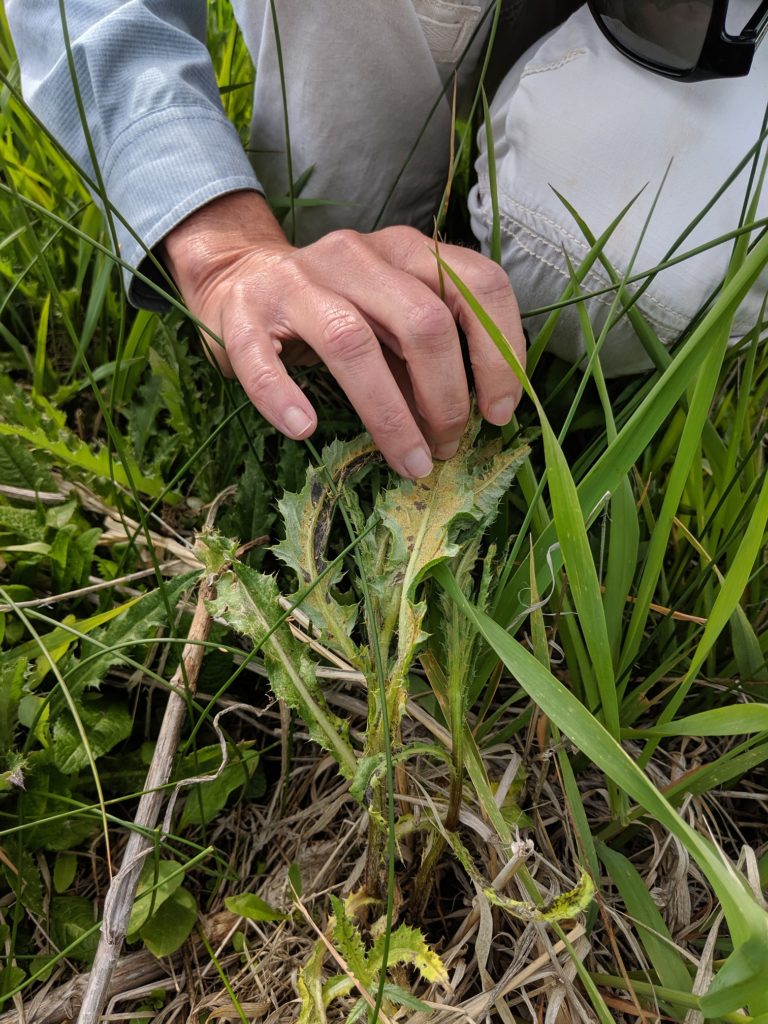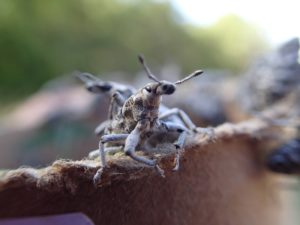

Integrated weed management (IWM) refers to weed control programs that utilize a combination of methods to contain unwanted plants on a landscape. Control methods include chemical, mechanical, and biological techniques and, ideally, are complemented by prevention strategies, monitoring, and restoration.
No two plants are alike. Noxious weeds employ a diverse set of strategies to survive, reproduce, and compete with native species. Likewise, no two management areas are alike. Site conditions – such as ecosystem type, weed population size, surrounding vegetation, recreation and wildlife use, and controller accessibility – vary greatly by location. As the most adaptable and comprehensive approach to weed control, integrated weed management yields far better results than reliance on any one strategy alone. Additionally, an integrated approach reduces the risk of noxious weeds developing resistance to herbicide or any form of treatment.
Mechanical treatment can be effective at both controlling noxious weed populations (independent of other control methods) and preparing management areas for further treatment. The most basic form of mechanical treatment is hand weeding. Small weed populations, such as those in a garden, backyard, or trailhead, can often be controlled with just a little bit of elbow grease! Dyers Woad, Myrtle Spurge, and Musk Thistle are all examples of weeds easily controlled by hand or shovel; just be sure to wear gloves, and bag them before seeds form.
Other forms of mechanical treatment include mowing, weed whacking, chopping and bagging seedheads, and burning. Depending on the plant, these actions alone may be enough to deter establishment and spread. More often, these treatments are used to thin noxious weed populations for improved controller access and enhanced future treatment.
Grazing is another low-tech weed control solution. Goats can maneuver loose, steep terrain better than the average person can and, when given the option, choose to consume forbs over native grasses. When managed carefully and strategically, grazing can refresh weedy landscapes.
 Biological control can significantly reduce noxious weed populations over time. Several weed species in our area have a match for biological control. Some examples of bugs the Summit CWMA uses for weed control include knapweed root weevils and stem weevils, toadflax stem-mining weevils, and leafy spurge flea beetles. Biocontrol species such as these are collected locally and released at target weed populations. Once established, the bugs feed, chew, burrow, or lay eggs in host plants, causing extensive damage to individual plants and reducing overall rates of survival and reproduction. While the effects of biological controls are not always immediate, they are substantial.
Biological control can significantly reduce noxious weed populations over time. Several weed species in our area have a match for biological control. Some examples of bugs the Summit CWMA uses for weed control include knapweed root weevils and stem weevils, toadflax stem-mining weevils, and leafy spurge flea beetles. Biocontrol species such as these are collected locally and released at target weed populations. Once established, the bugs feed, chew, burrow, or lay eggs in host plants, causing extensive damage to individual plants and reducing overall rates of survival and reproduction. While the effects of biological controls are not always immediate, they are substantial.
Biological control is particularly helpful for managing weed populations in remote, steep, or hard to access areas. Additionally, since biological control species are selective – meaning they only attack their host species – they can be applied to areas with sensitive nearby vegetation. Because it takes time for insects to establish, biocontrol methods are often paired with mechanical or chemical control.
Chemical control is typically a component of IWM programs. Some species – particularly those with substantial root structures or those that spread via rhizomes – respond best to chemical treatment. Canada thistle, leafy spurge, garlic mustard and several other noxious species are nearly impossible to control through mechanical and biological methods; in these cases, chemical treatments are necessary. The Summit CWMA uses selective herbicide to ensure the best results and the least damage to surrounding vegetation.
 Restoration is just as important as weed control. After a weed population is determined absent or adequately controlled, the Summit CWMA redirects its efforts towards restoring the affected area. In some cases, all it takes is a few handfuls of native grass seed to bring a spot back to life; in others, nitrogen-fixing wildflowers such as lupine are added to the mix to put nutrients back into the soil. In more extreme cases, soil amendments, biochar, or mature plants are necessary to reestablish a healthy ecosystem.
Restoration is just as important as weed control. After a weed population is determined absent or adequately controlled, the Summit CWMA redirects its efforts towards restoring the affected area. In some cases, all it takes is a few handfuls of native grass seed to bring a spot back to life; in others, nitrogen-fixing wildflowers such as lupine are added to the mix to put nutrients back into the soil. In more extreme cases, soil amendments, biochar, or mature plants are necessary to reestablish a healthy ecosystem.
Restoration not only is esthetically pleasing and beneficial for native pollinators, but also prevents weeds from reentering the area. Bare soil is always an invitation for noxious and obnoxious weeds to establish themselves. Moreover, many noxious species are allelopathic – to outcompete native species, they add growth-inhibiting chemicals to the soil – and have negative impacts on soil chemistry and beneficial fungal communities. Before desired species can be expected to naturally re-enter an area, work must be done to improve baseline conditions. Soil restoration and reintroduction of native species is integral to long-term weed control.
Prevention is key! Help us stop the spread of noxious weeds! Noxious weeds are colonizer species and, thus, love soil disturbance. Before embarking on any project that disturbs soil – from large-scale construction, to agriculture, to carving out a small garden bed – be sure to monitor the site for weeds and treat them appropriately. Once your project is complete, reseed the area so invaders can’t move in.
Also remember to recreate responsibly! Summit County and the surrounding areas have incredible trail and open space access. Unfortunately, it’s hard not to take weed seeds along for the ride. To limit the spread of noxious weeds when hiking or biking, stay on-trail as much as possible and take the time to clean your shoes and equipment between outings.